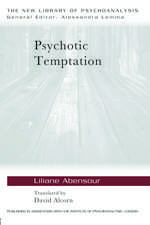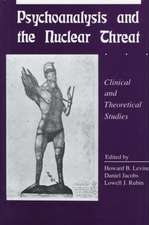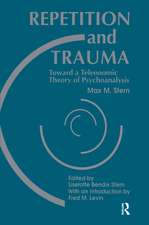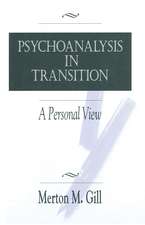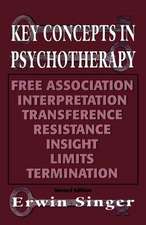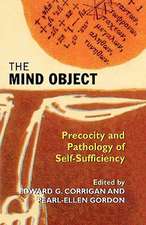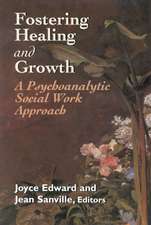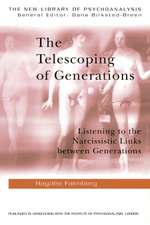On Bearing Unbearable States of Mind: The New Library of Psychoanalysis
Autor Ruth Riesenberg-Malcolm Editat de Priscilla Rothen Limba Engleză Paperback – 11 feb 1999
On Bearing Unbearable States of Mind provides clear guidance on how the analyst can encourage the patient to communicate the quality of their often intolerably painful states of mind, and how he/she can interpret these states, using them as a basis for insight and psychic change in the patient. Employing extensive and detailed clinical examples, and addressing important areas of Kleinian theory, the author examines the problems that underlie severe pathology, and shows how meaningful analytic work can take place, even with very disturbed patients.
On Bearing Unbearable States of Mind will be a useful and practical guide for psychoanalysts and psychotherapists, and all those working in psychological settings with severely disturbed patients.
Din seria The New Library of Psychoanalysis
- 5%
 Preț: 293.44 lei
Preț: 293.44 lei - 5%
 Preț: 264.13 lei
Preț: 264.13 lei - 5%
 Preț: 233.66 lei
Preț: 233.66 lei - 5%
 Preț: 295.02 lei
Preț: 295.02 lei - 5%
 Preț: 298.13 lei
Preț: 298.13 lei - 5%
 Preț: 316.86 lei
Preț: 316.86 lei - 5%
 Preț: 294.02 lei
Preț: 294.02 lei - 5%
 Preț: 234.37 lei
Preț: 234.37 lei - 5%
 Preț: 349.43 lei
Preț: 349.43 lei - 5%
 Preț: 273.05 lei
Preț: 273.05 lei -
 Preț: 295.41 lei
Preț: 295.41 lei - 5%
 Preț: 289.20 lei
Preț: 289.20 lei - 5%
 Preț: 233.60 lei
Preț: 233.60 lei - 5%
 Preț: 373.84 lei
Preț: 373.84 lei - 5%
 Preț: 253.71 lei
Preț: 253.71 lei - 5%
 Preț: 218.59 lei
Preț: 218.59 lei - 5%
 Preț: 233.06 lei
Preț: 233.06 lei - 5%
 Preț: 250.75 lei
Preț: 250.75 lei - 5%
 Preț: 295.41 lei
Preț: 295.41 lei -
 Preț: 309.79 lei
Preț: 309.79 lei -
 Preț: 294.24 lei
Preț: 294.24 lei - 5%
 Preț: 331.66 lei
Preț: 331.66 lei - 5%
 Preț: 282.41 lei
Preț: 282.41 lei - 5%
 Preț: 294.71 lei
Preț: 294.71 lei - 5%
 Preț: 287.55 lei
Preț: 287.55 lei - 5%
 Preț: 280.60 lei
Preț: 280.60 lei - 5%
 Preț: 231.83 lei
Preț: 231.83 lei -
 Preț: 336.85 lei
Preț: 336.85 lei - 5%
 Preț: 259.78 lei
Preț: 259.78 lei -
 Preț: 347.68 lei
Preț: 347.68 lei - 5%
 Preț: 259.64 lei
Preț: 259.64 lei - 5%
 Preț: 762.86 lei
Preț: 762.86 lei - 5%
 Preț: 235.05 lei
Preț: 235.05 lei - 5%
 Preț: 219.54 lei
Preț: 219.54 lei - 5%
 Preț: 266.39 lei
Preț: 266.39 lei - 5%
 Preț: 344.75 lei
Preț: 344.75 lei - 5%
 Preț: 295.21 lei
Preț: 295.21 lei - 5%
 Preț: 287.95 lei
Preț: 287.95 lei - 21%
 Preț: 811.99 lei
Preț: 811.99 lei - 19%
 Preț: 246.34 lei
Preț: 246.34 lei - 5%
 Preț: 362.47 lei
Preț: 362.47 lei - 11%
 Preț: 278.48 lei
Preț: 278.48 lei - 5%
 Preț: 365.37 lei
Preț: 365.37 lei - 5%
 Preț: 363.52 lei
Preț: 363.52 lei - 5%
 Preț: 382.02 lei
Preț: 382.02 lei - 5%
 Preț: 377.07 lei
Preț: 377.07 lei - 5%
 Preț: 379.20 lei
Preț: 379.20 lei - 5%
 Preț: 388.07 lei
Preț: 388.07 lei
Preț: 367.79 lei
Preț vechi: 387.16 lei
-5% Nou
Puncte Express: 552
Preț estimativ în valută:
70.38€ • 76.43$ • 59.12£
70.38€ • 76.43$ • 59.12£
Carte tipărită la comandă
Livrare economică 22 aprilie-06 mai
Preluare comenzi: 021 569.72.76
Specificații
ISBN-13: 9780415205191
ISBN-10: 0415205190
Pagini: 216
Dimensiuni: 156 x 234 x 17 mm
Greutate: 0.4 kg
Ediția:1
Editura: Taylor & Francis
Colecția Routledge
Seria The New Library of Psychoanalysis
Locul publicării:Oxford, United Kingdom
ISBN-10: 0415205190
Pagini: 216
Dimensiuni: 156 x 234 x 17 mm
Greutate: 0.4 kg
Ediția:1
Editura: Taylor & Francis
Colecția Routledge
Seria The New Library of Psychoanalysis
Locul publicării:Oxford, United Kingdom
Public țintă
Postgraduate, Professional, and Professional Practice & DevelopmentCuprins
Roth, General Introduction. Part I: The Internal World in the Transference. Roth, Introduction. The Mirror: A Perverse Sexual Phantasy Seen in a Woman as a Defence Against Psychotic Breakdown. Interpretation: The Past in the Present. The Constitution and Operation of the Superego. Construction as Reliving History. Part II: Defences Against Anxieties of the Depressive Position. Roth, Introduction. Self-punishment as Defence. Technical Problems in the Analysis of a Pseudo-compliant Patient. As-if: The Phenomenon of Not Learning. Hyperbole in Hysteria: 'How Can We Know the Dancer from the Dance.' Pain, Sorrow and Resolution. Part III: Theoretical Refinements. Roth, Introduction. The Three W's: What, Where and When: The Rationale of Interpretation. Conceptualisation of Clinical Facts in the Analytic Process.
Recenzii
I was most struck by the details of her clinical work with the array of patients that constitutes an analyst's practice. Firmly based in Kleinian theory and technique, Riesenberg-Malcolm shows sensitivity in working closely with the clinical material of patients who represent the severe psychopathologies. Her elaborate descriptions of clinical material, startin in the first paper in the collection, on "The Mirror", allow readers to immerse themselves within the deeply disturbing world of perversion and borderline-psychotic states. Even from a differing clinical vantage point one can follow her clinical logic through the evolution of her interpretations. Excellent case descriptions permit us to form our own ideas about etiology and clinical intervention, a possibility not always afforded readers when briefer vignettes are provided. - Abbot A.Bronstein, IJPA 83 (1), 2002
'...a remarkable series of papers, noteworthy for their clarity on what many analysts are concerned with today: the complex issue of the positions of mutual influence in the consulting-room - the ways in which the patient through projective identification exerts a subtle pressure on the analyst to recreate early object relations and the manner in which the analyst as a recipient of these projections is inevitably drawn into this in some way, and under these pressures is 'recruited' to enact something of the patient's disturbing primitive object relations. ...Therapists will be richly rewarded by the thoughtful and detailed descriptions of analytic work with patients who often seem unreachable. I believe they will find their clinical thinking deepened and challenged by this book.' - Erika Bard, Member of the British Psychoanalytical Society.
I was most struck by the details of her clinical work with the array of patients that constitutes an analyst's practice. Firmly based in Kleinian theory and technique, Riesenberg-Malcolm shows sensitivity in working closely with the clinical material of patients who represent the severe psychopathologies. Her elaborate descriptions of clinical material, startin in the first paper in the collection, on "The Mirror", allow readers to immerse themselves within the deeply disturbing world of perversion and borderline-psychotic states. Even from a differing clinical vantage point one can follow her clinical logic through the evolution of her interpretations. Excellent case descriptions permit us to form our own ideas about etiology and clinical intervention, a possibility not always afforded readers when briefer vignettes are provided. - Abbot A.Bronstein, IJPA 83 (1), 2002
'...a remarkable series of papers, noteworthy for their clarity on what many analysts are concerned with today: the complex issue of the positions of mutual influence in the consulting-room - the ways in which the patient through projective identification exerts a subtle pressure on the analyst to recreate early object relations and the manner in which the analyst as a recipient of these projections is inevitably drawn into this in some way, and under these pressures is 'recruited' to enact something of the patient's disturbing primitive object relations. ...Therapists will be richly rewarded by the thoughtful and detailed descriptions of analytic work with patients who often seem unreachable. I believe they will find their clinical thinking deepened and challenged by this book.' - Erika Bard, Member of the British Psychoanalytical Society.
I was most struck by the details of her clinical work with the array of patients that constitutes an analyst's practice. Firmly based in Kleinian theory and technique, Riesenberg-Malcolm shows sensitivity in working closely with the clinical material of patients who represent the severe psychopathologies. Her elaborate descriptions of clinical material, startin in the first paper in the collection, on "The Mirror", allow readers to immerse themselves within the deeply disturbing world of perversion and borderline-psychotic states. Even from a differing clinical vantage point one can follow her clinical logic through the evolution of her interpretations. Excellent case descriptions permit us to form our own ideas about etiology and clinical intervention, a possibility not always afforded readers when briefer vignettes are provided. - Abbot A.Bronstein, IJPA 83 (1), 2002
Descriere
Reisenberg-Malcolm provides clear guidance on how the analyst can encourage the patient to communicate their often intolerably painful states of mind, and how to interpret these communications.


